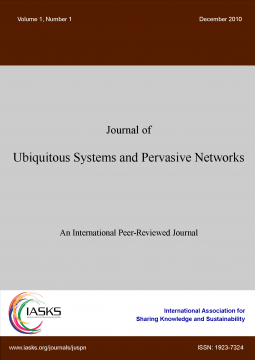volume-19-Issue 1 (2023)
Latest Articles
PATTERN DETECTION IN MARITIME TRAFFIC FOR SAFETY ANALYSIS USING DEEP LEARNING
JUSPN, volume-19, Issue 1 (2023) , PP 33 - 38
Published: 06 Dec 2023
DOI: 10.5383/JUSPN.19.01.004
by Bill Karakostas from Independent Researcher. Manchester, UK
Abstract: The paper presents a novel approach for the detection of ship collision risks, by classifying images of ship traffic constructed from AIS data, using deep learning techniques. In this approach, the risk level of ship traffic patterns, according to maritime safety rules, is calculated, using a convolutional neural network trained on ship traffic image data. Experiments with the analysis of real ship traffic data from the English Channel are reported. read more... read less...
Keywords: AIS, COLREG, maritime safety, autonomous ships, computer vision, CNN, Deep Learning, Keras
Exploring Privacy Threats in Connected and Autonomous Vehicles: An Analysis
JUSPN, volume-19, Issue 1 (2023) , PP 25 - 32
Published: 06 Dec 2023
DOI: 10.5383/JUSPN.19.01.003
by Badreddine Chah, Alexandre Lombard, Anis Bkakria, Reda Yaich, Abdeljalil Abbas-Turki from CIAD UMR 7533, Univ. Bourgogne-Franche-Comté, UTBM, F-90010 Belfort, France and IRT SystemX, Palaiseau 91120, France
Abstract: This paper conducts a privacy threat analysis of connected and autonomous vehicles to address the growing concerns regarding the privacy of sensitive information collected by these vehicles. By following the LINDDUN GO methodology, this paper aims to identify privacy risks in the overall connected and autonomous vehicles architecture based on formal privacy requirements. The proposed analysis focuses on a specific use case, assisting manufacturers in implementing privacy requirements and enhancing privacy protection. This research provides valuable insights into potential risks and vulnerabilities, contributing to the development of privacy-respecting connected and autonomous vehicle systems. read more... read less...
Keywords: Privacy, Security, Threat Analysis, Connected and Autonomous Vehicle, Privacy engineering framework
Performance Analysis and Functionality Comparison of First Hop Redundancy Protocol IPV6
JUSPN, volume-19, Issue 1 (2023) , PP 15 - 23
Published: 06 Dec 2023
DOI: 10.5383/JUSPN.19.01.002
by Mahmud Mansour, Najia Ben Saud from Department of Network, University of Tripoli, Tripoli, Libya
Abstract: High level of availability can be expensive to maintain, but lack of availability may also increase cost as it may damage the reputation of the business. Which led to the development of techniques that reduce downtime until it became transparent to the user. First hop redundancy protocols (FHRP) are an essential tool for improving the availability of IP networks. The first hop redundancy protocols are protocols used to manage and maintain network default gateway routers by using one or more redundant routers that will take over in case of default router failure. Each protocol has its own purpose. FHRP was developed to reduce traffic loss. In this paper we present the first hop redundancy concept and the means for its realization in IPv6 network. We evaluate three FHRP protocols, namely, the Hot Standby Router Protocol (HSRPv2), Virtual Router Redundancy Protocol (VRRPv3), and Gateway Load Balancing (GLBP). The First Hop Redundancy Protocols will be implemented, tested, optimized, and compared to one another in terms of convergence time, packet loss and CPU utilization, by using GNS3 simulator and Wireshark the results of comparison will be provided and analyzed. The performances of the three FHRP protocols are analyzed, and their functionalities are compared. The comparison results highlight which protocol performed the best in each scenario and which protocol can be considered as the best among the three FHRPs. read more... read less...
Keywords: VRRP, FHRP, HSRP, GLBP
Handling Safety and Cybersecurity Interdependency in NFV Safety Architecture With the Use of An Ontology-based Solution
JUSPN, volume-19, Issue 1 (2023) , PP 01 - 13
Published: 06 Dec 2023
DOI: 10.5383/JUSPN.19.01.001
by Dionysia Varvarigou, David Espes, Giacomo Bersano from Université de Bretagne Occidentale, Brest, France, 29238 and Ikos consulting, Paris, France
Abstract: In case safety-critical systems face an anomaly (either intentional or not), safety and cybersecurity impact humans and environment. Thus, they affect each other and so they are considered as interdependent. An ontology-based solution for safety is needed to handle this interdependency. We propose a new safety ontology for Network Function Virtualization (NFV) framework which is able to cover reliability, availability, maintainability, and integrity-related breakdown types, since they interact and influence safety according to ENISA. Our ontology allows us to have a uniformized representation of the potential anomalies that a system and its elements can face. Based on this representation, a decision-making process takes place to avoid potential conflicts between safety and cybersecurity, in order to best handle their interdependency. The results of our implementation show that our ontology handles the safety and cybersecurity interdependency, and has little impact on decision-making time, which makes it an effective methodology for NFV framework. read more... read less...
Keywords: Safety ontology, NFV safety architecture, Safety and cybersecurity interdependency

